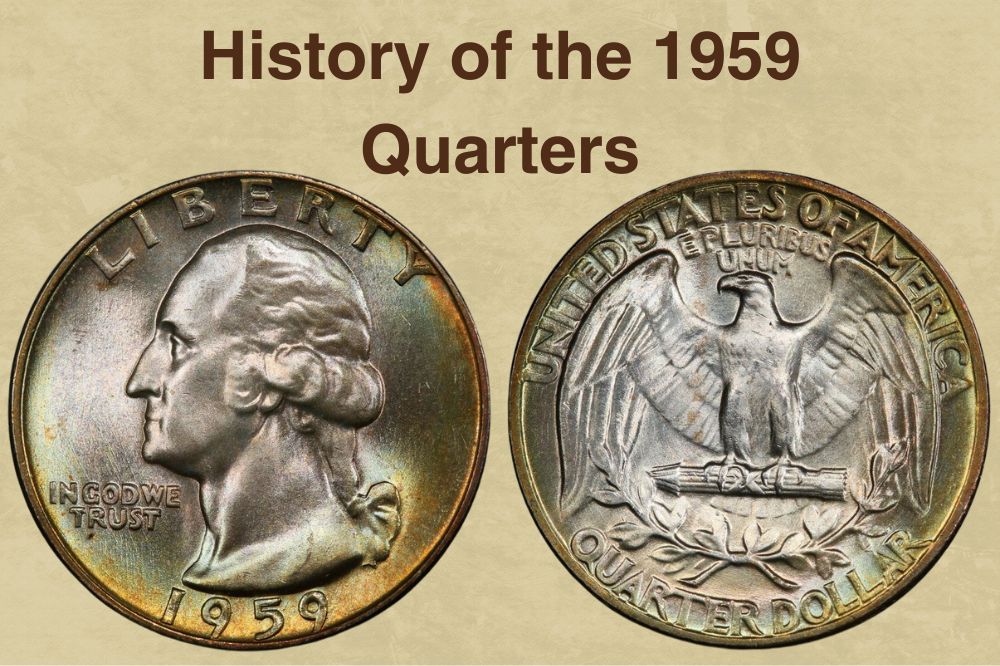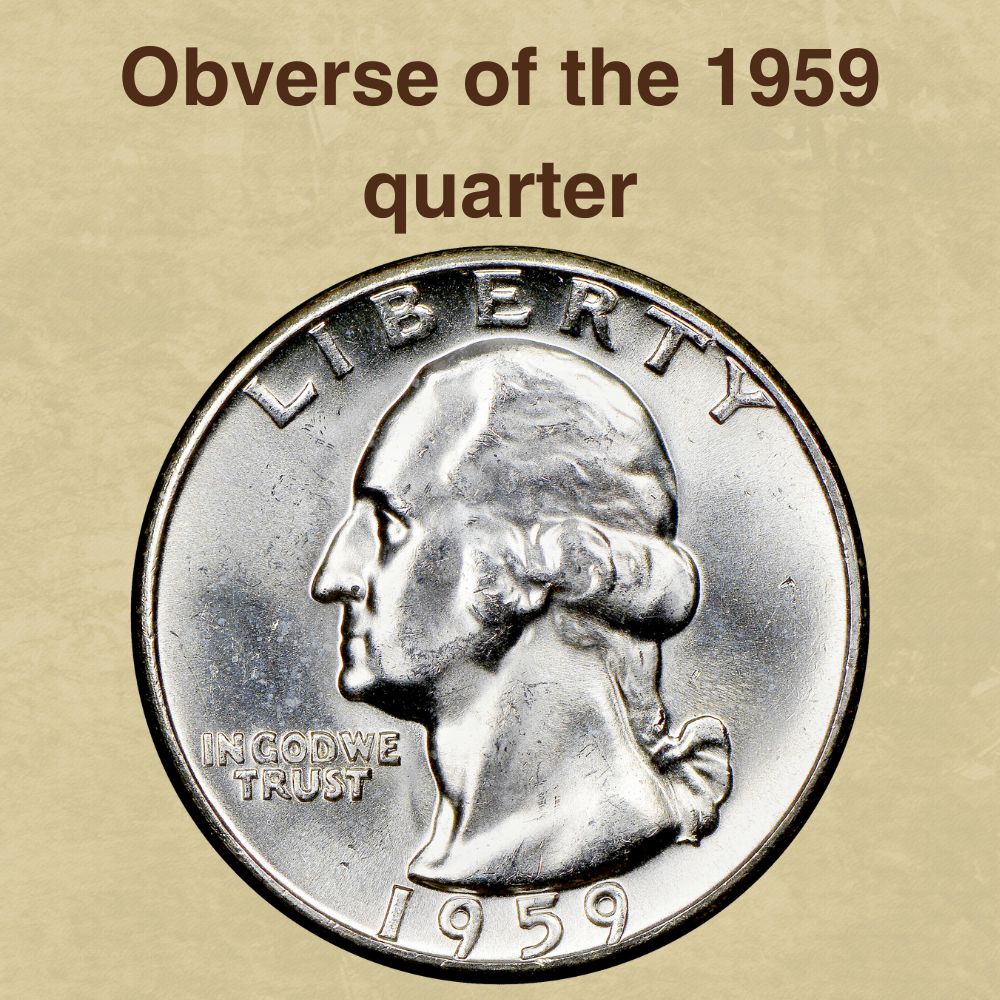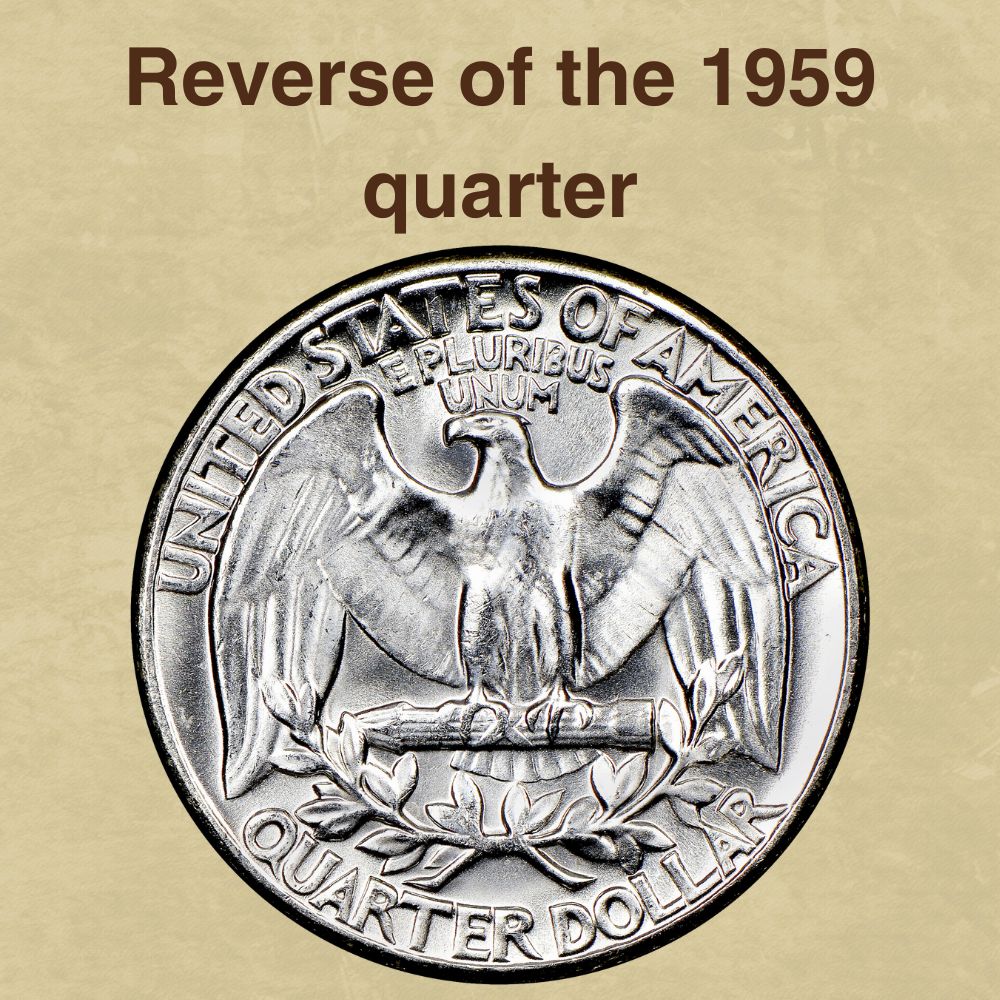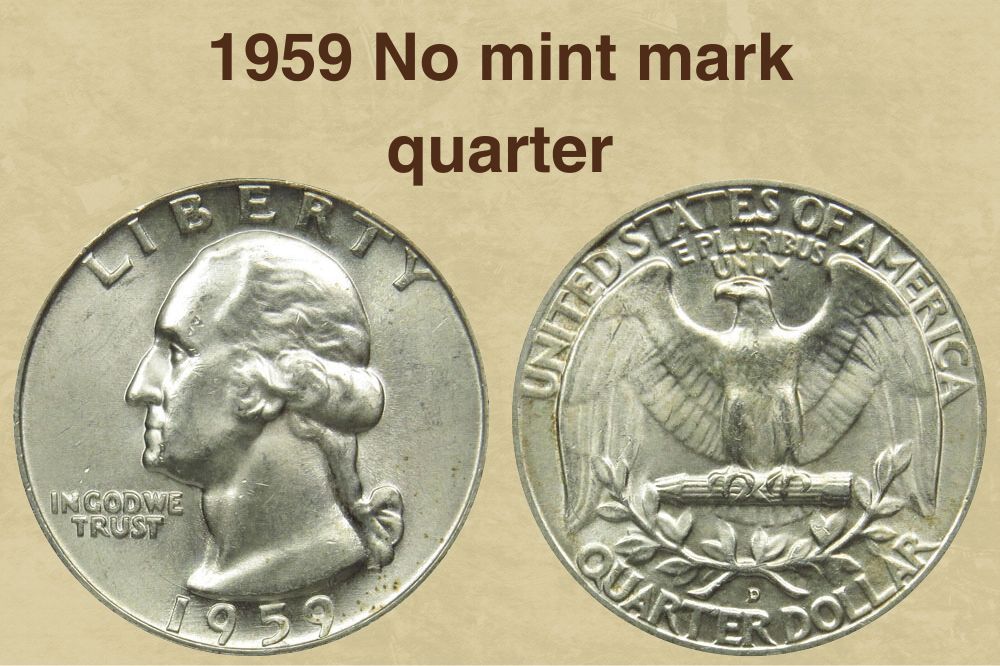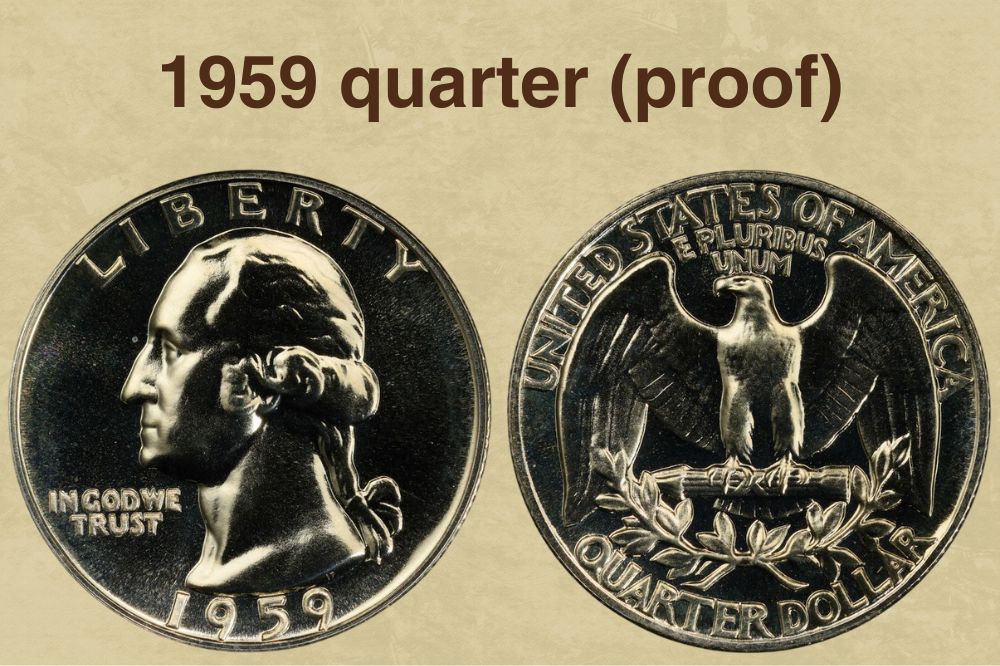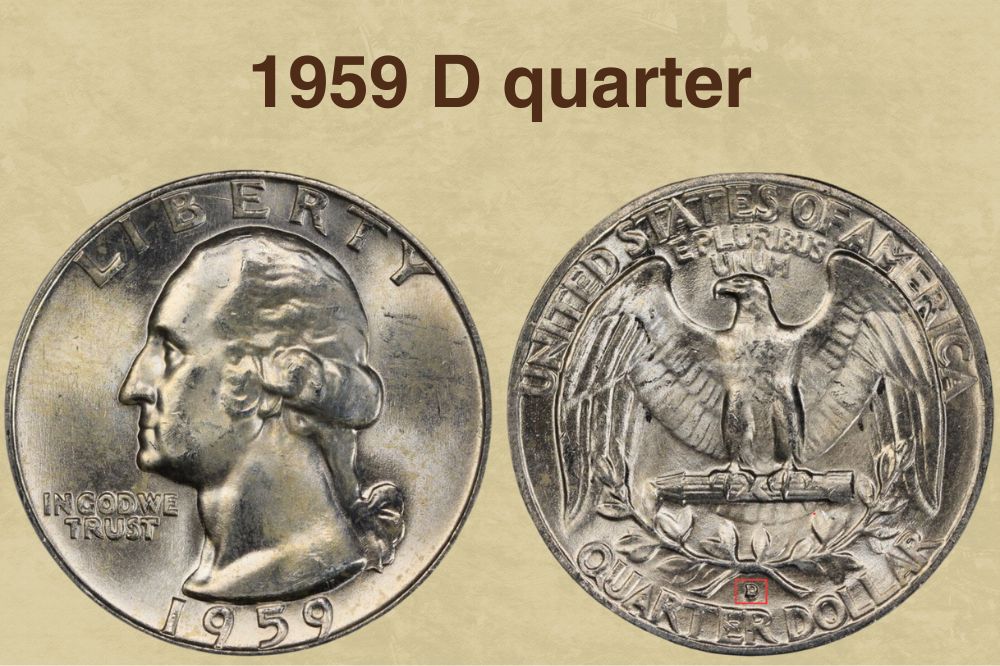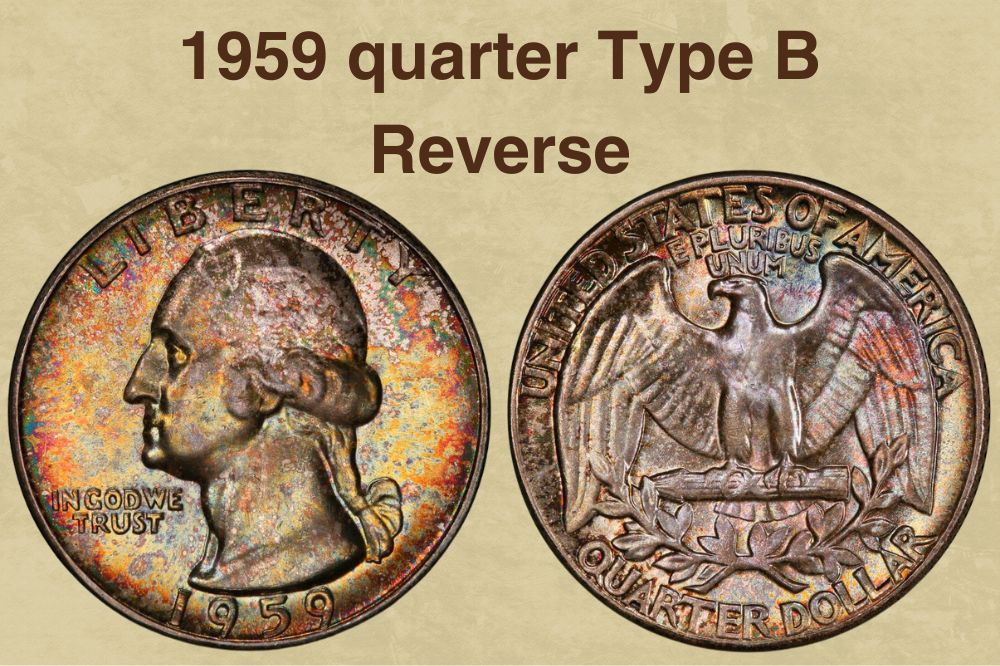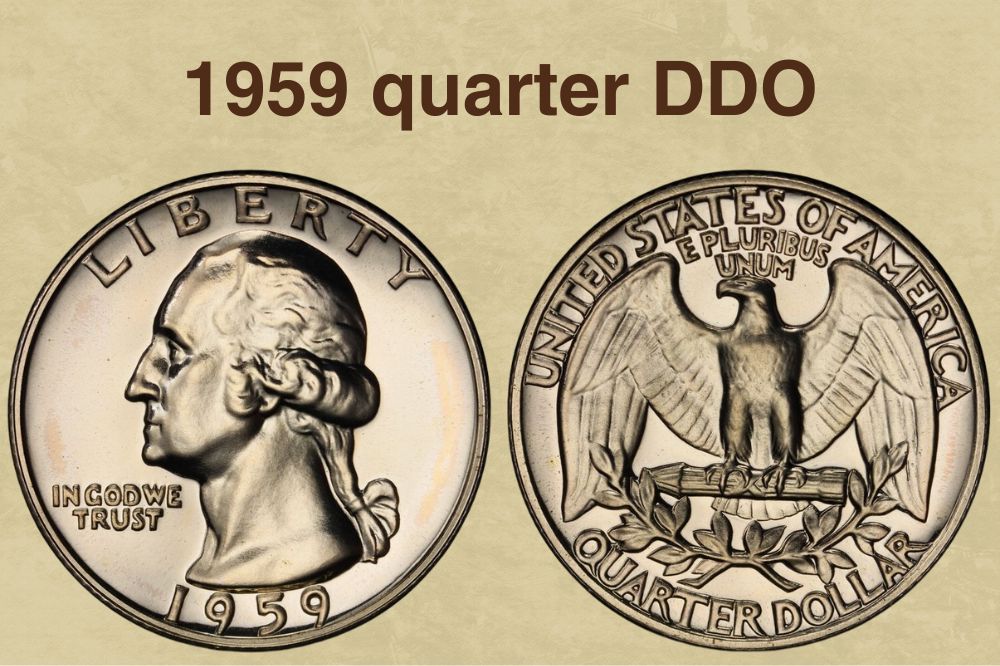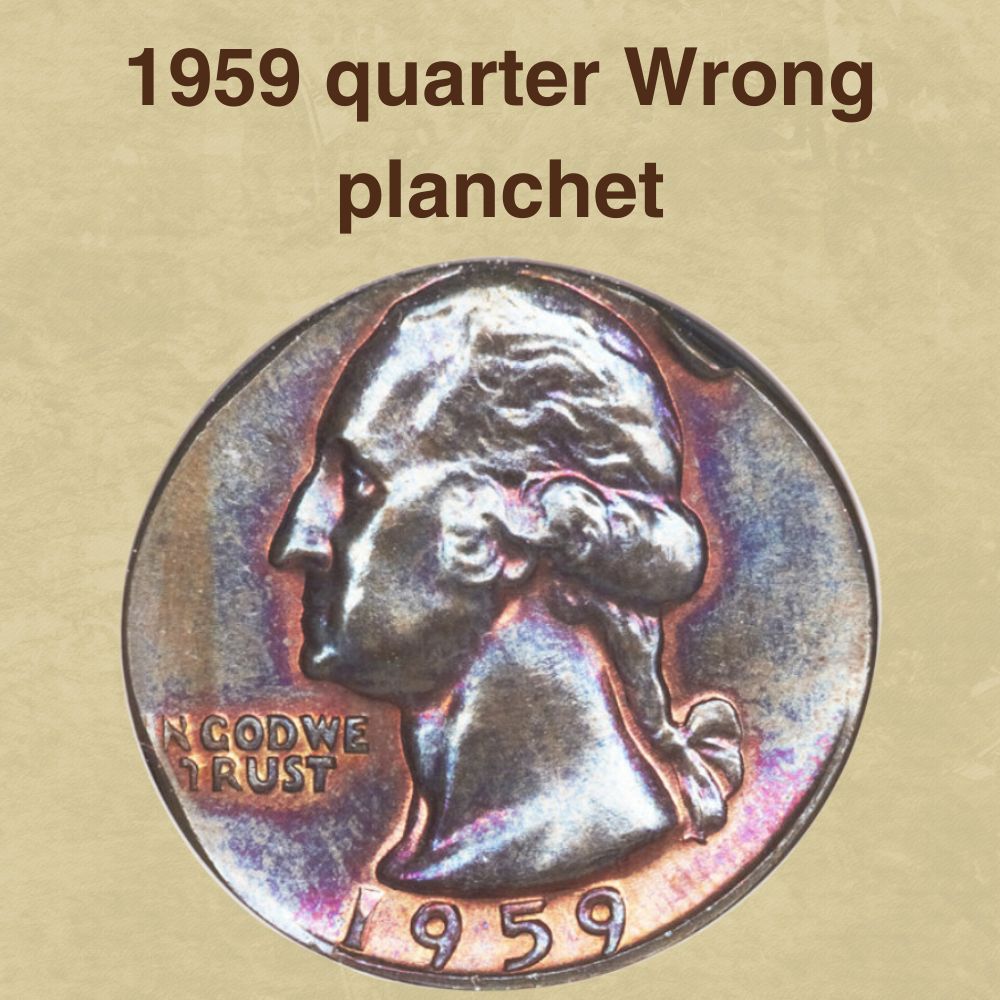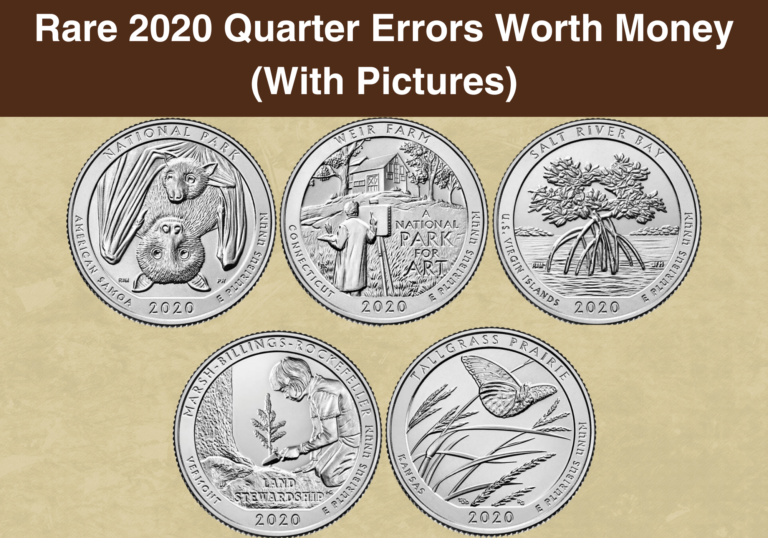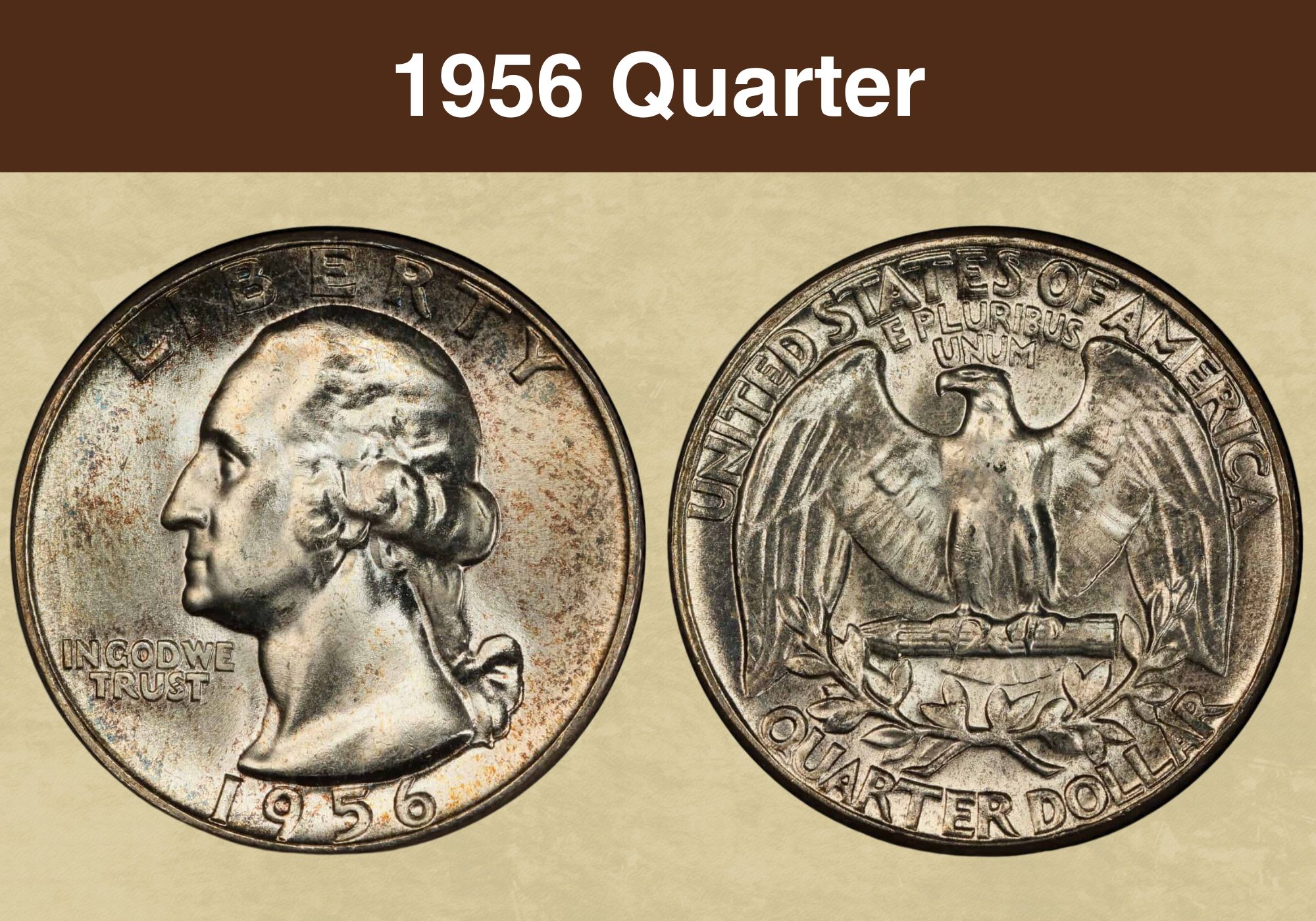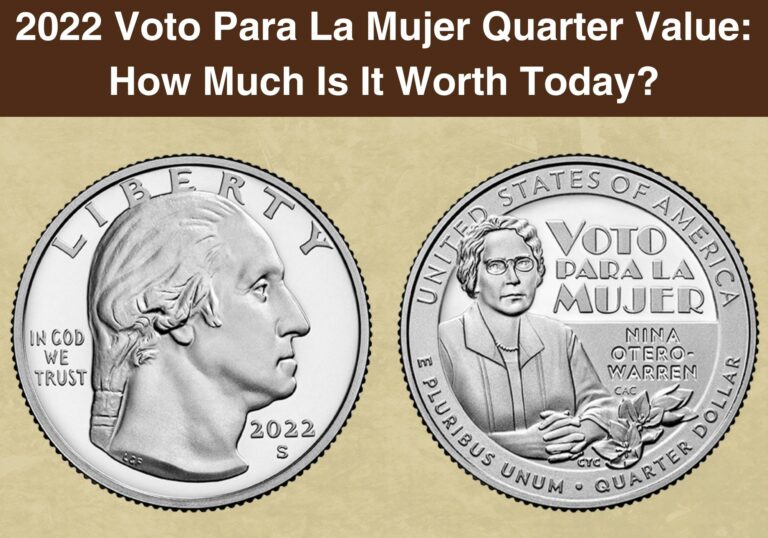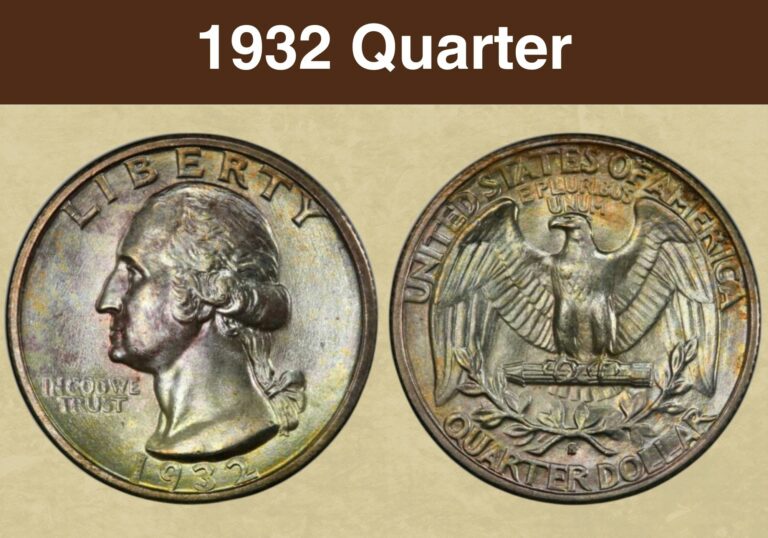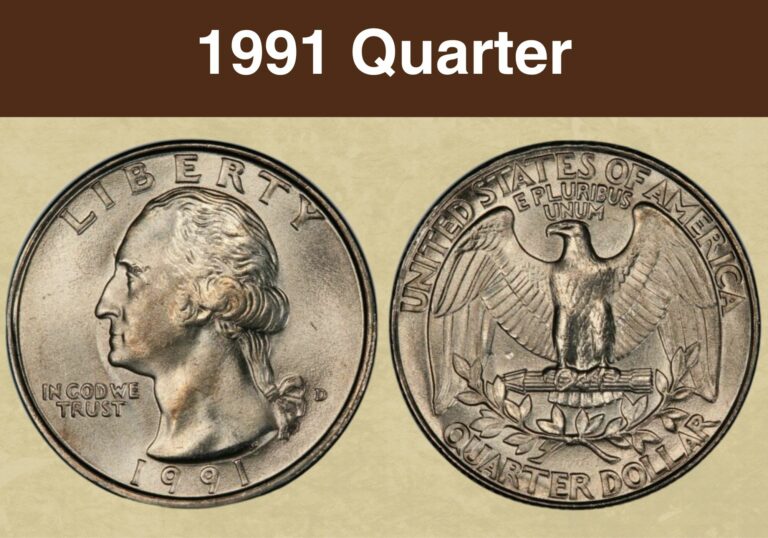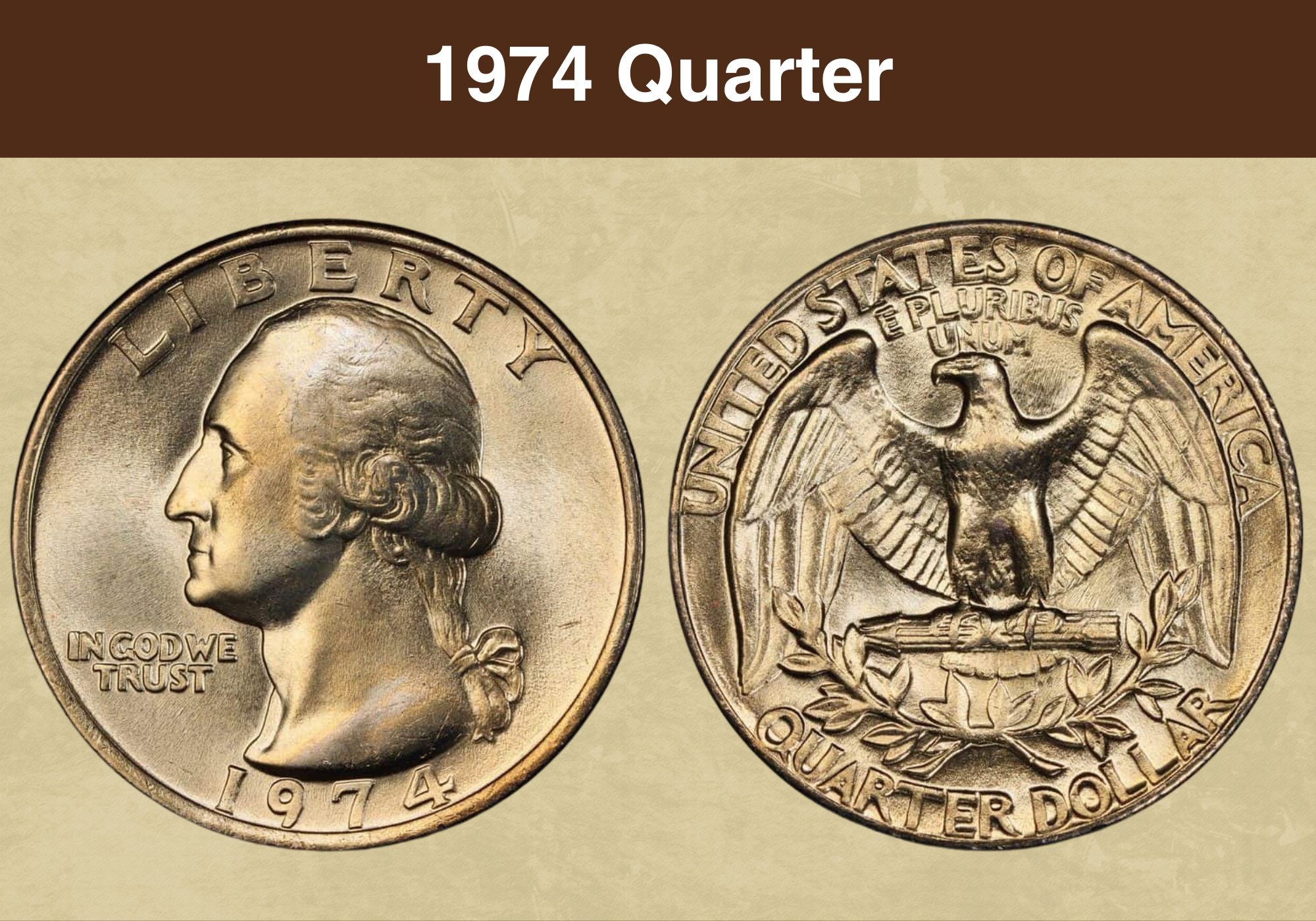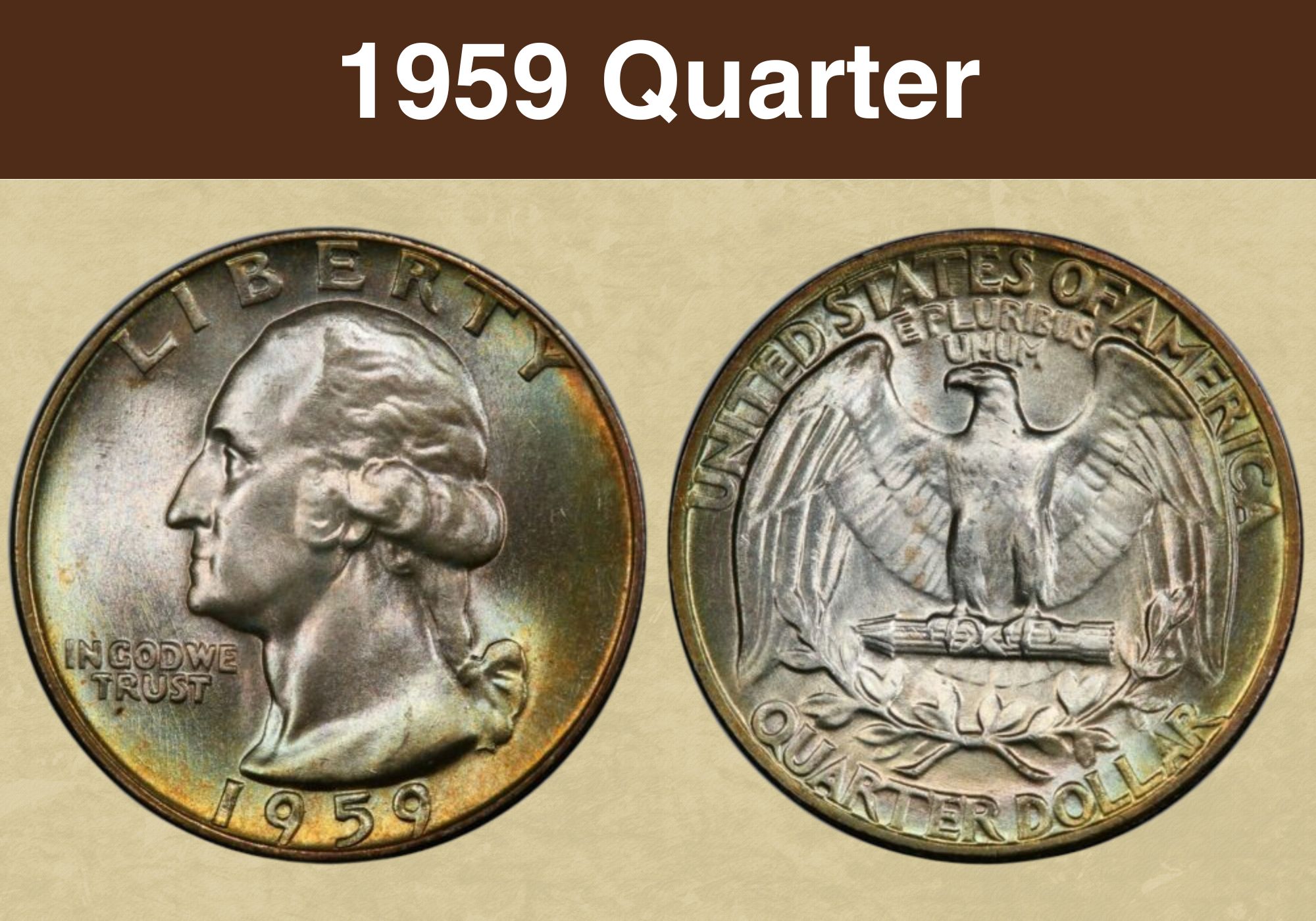
Coin Value Contents Table
- 1959 quarter value Chart
- History of the 1959 Quarters
- 1959 quarter Types
- Features of the 1959 Quarters
- 1959 Quarter Grading Guides
- 1959 Quarter Value Guides
- 1959 No mint mark quarter Value
- 1959 quarter Value (proof)
- 1959 D quarter Value
- Rare 1959 Quarter Errors List
- Where to Sell Your 1959 Quarter ?
- FAQ about the 1959 Quarter
The US Mint dedicated the Washington quarters to the 200th anniversary of this President’s birth. Their 85-year production began in 1932, making them one of the longest-lived coins.
This American coinage belongs to one of the most collected series, affecting the 1959 quarter value. The author of this simple design is John Flanagan, who created the complete obverse and reverse.
1959 quarter value Chart |
||
| Condition | 1959 no mint mark quarters | 1959 D quarters |
| Good | $6 | $6 |
| Very good | $6 | $6 |
| Fine | $6 | $6 |
| Very fine | $6 | $6 |
| Extra fine | $6 | $6 |
| AU | $7 | $7 |
| Mint state 60 | $10 | $10 |
| Mint state 65 | $28 | $28 |
| Proof 65 | $18 | / |
History of the 1959 Quarters
The initial purpose of the Washington quarter was to honor the first President with a one-year commemorative coin. The approach of his 200th anniversary of birth included preparations for the celebration of this jubilee from 1924, but the activities were not intense at the beginning.
The officials chose the work of Mrs. Gardin Fraser among the significant number of received design solutions for this coin. However, the new quarters finally got the John Flanagan’s design, selected by the Treasury Secretary.
The historical importance and beauty of these coins explains the interest of numismatists in collecting them. However, it is increasingly difficult to find perfectly preserved quarters, especially those from the early period.
1959 quarter Types |
||
| Location | Year | Minted |
| Philadelphia | 1959 no mint mark quarter | 24,384,000 |
| Philadelphia | 1959 proof quarter | 1,149,291 |
| Denver | 1959 D quarter | 62,054,232 |
| Total | / | 87,587,523 |
Silver was the primary metal in the original quarter composition because the US Mint produced most coinage by using this precious metal. The change in its value on the stock market forced officials to find a more economical solution. In 1965, copper and nickel became a part of the quarter composition.
Also read: Top 13 Most Valuable State Quarters Worth Money
Features of the 1959 Quarters
All American coins went through changes in design and composition during their lifetime. It was the same with the Washington quarters replacing the previous 25-cent coins, the Standing Liberty quarters. All pieces minted before 1965, including those struck in 1959, contained silver.
The obverse of the 1959 quarter
The profile of George Washington on the obverse is a tribute to the first American President. His left-facing profile occupies the central part, but the designer didn’t pay much attention to details except for the recognizable hairstyle.
In addition to the bust, you can also read inscriptions, such as the word LIBERTY on the upper rim and the minting year stretching along the lower coin part. The phrase IN GOD WE TRUST is visible on the left side.
The reverse of the 1959 quarter
The reverse design is not simple and shows numerous national symbols. In the center, you can see an eagle spreading both wings while tightly holding arrows. Below are two crossed olive branches.
On the upper rim, you can read the State name. Directly below this inscription is the saying E PLURIBUS UNUM, while the denomination (QUARTER DOLLAR) is along the lower rim.
1959 quarter Details |
|
| Face value | 25 cents ($0.25) |
| Compound | Silver (0.900) and copper |
| Silver weight | 0.18084 troy ounces (5.62 g) |
| Coin weight | 0.20094 ounces (6.25 g) |
| Coin diameter | 0.95669 inches (24.3 mm) |
| Coin thickness | 0.06890 inches (1.75 mm) |
| Edge | Reeded |
| Shape | Round |
Other features of the 1959 quarter
The 1959 quarter is round in shape with a reeded rim and composition that includes 90% silver. A diameter of 0.95669 inches (24.3 mm) and a thickness of 0.06889 inches (1.75 mm) are standard features for this coinage. Each coin weighs 0.20094 ounces (6.25 g) and has a silver weight of 0.18084 troy ounces (5.62 g).
Also read: Top 16 Most Valuable Modern Quarters Worth Money
1959 Quarter Grading Guides
It is best to hire a professional appraiser when it is necessary to evaluate your quarter reliably. Such an expert primarily assesses the current coin’s appearance, with special reference to its condition.
To make this grading uniform, numismatist Dr. William Sheldon established a way of coin grading in 1949. After his grading scale’s adaption in the 1970s, it became a standard accepted by all collectors.
| # | Grade |
|---|---|
| 1 | Basal State-1 |
| 2 | Fair |
| 3 | Very Fair |
| 4, 5, 6 | Good |
| 7, 8, 10 | Very Good |
| 12, 15 | Fine |
| 20, 30 | Very Fine |
| 40 | Extremely Fine |
| 50 | About Uncirculated |
| 60 | Mint State |
| 65 | Mint State |
| 70 | Mint State |
Please check our grading guides to know your coin scale, It’s the necessary step to know the exact value of your coin.
Check out now: How to Grade Washington Quarter?
1959 Quarter Value Guides
The total circulation of Washington quarters from 1959 was 87,587,523 pieces. The US Mint minted these coins in two mints, with the one in Philadelphia that released proof quarters in addition to regular ones.
1959 No mint mark quarter Value
The Philadelphia mint contributed to the total mintage, with 24,384,000 quarters produced that year. You can tell them apart by the lack of the mint mark on the obverse.
Collectors can buy coins from circulation for an affordable $6. A slightly higher price of $10 is available for specimens in the mint state, graded MS 60 to MS 62.
As the grade increases, so does the coin’s value. Therefore, it is necessary to set aside between $14 and $50 for pieces graded MS 63 to MS 66. Expectedly, the highest price is for specimens with an MS 67 rating.
In many cases, their value ranges from $600 to $1,000. However, the auction amounts are somewhat different. The 1959 MS 67 Washington quarter reached an exceptional price of $17,250 in 2012.
1959 quarter Value (proof)
The proof mintage in 1959 was over a million specimens. More precisely, the Philadelphia mint issued 1,149,291 of these coins.
You can buy these collectibles in the lower grades at affordable prices. For coins graded between PR 60 and PR 64, the price is $4.10 to $15. The value of specimens with PR 65 to PR 68 rating is $18 to $48, while the most expensive ones in PR 69 grade cost $90.
The record price for one such coin was $900. One quarter graded PR 25 was sold at that price on eBay in 2022. On the other hand, specimens with a cameo effect have a higher value depending on their quality:
- $42 for the 1959 PR 66-rated quarter
- $70 for the 1959 PR 67-rated quarter
- $150 for the 1959 PR 68-rated quarter
- $425 for the 1959 PR 69-rated quarter
The most expensive is the 1959 PR 68 CAM quarter. This specimen reached $823 at auction in 2013.
However, proof coins with the DCAM effect are even more valuable. You can buy those with a PR 68 rating for $800. On the other hand, a piece in PR 69 grade can cost as much as $13,000.
Nevertheless, the auction price of one of the 1959 PR 68 Washington DCAM quarters is significantly higher. It reached an incredible $11,750 in 2018.
1959 D quarter Value
The highest mintage of quarters was in Denver. This mint produced 62,054,232 pieces bearing the struck mark D this year.
The current price of circulated coins is $4.86, while specimens in the mint state graded from MS 60 to MS 62 are worth $10. On the other hand, you can buy pieces rated between MS 63 and MS 66 for a price ranging from $14 to $90.
The most money you need to set aside for one of the coins in MS 67 grade. Such specimens typically cost between $550 and $1,000, but the auction record of $14,950 from 2012 also belongs to one of the coins with that quality.
Also read: 17 Most Valuable Quarter Errors Worth Money
Rare 1959 Quarter Errors List
Regardless of the effort invested, the US Mint was unable to avoid errors when minting coins, especially during the years with high mintage. Therefore, you can expect imperfections to be inevitable among over 87 million Washington quarters minted in 1959.
Type B Reverse
This error is relatively rare and unusual. These are coins with a regularly minted obverse, while the reverse has the design of a proof coin. In the case of quarters from 1959, you can find them among the specimens of both mints.
Such coins from Philadelphia are somewhat more expensive, with the 1959 quarter Type B Reverse in MS 66+ grade reaching the highest price. One numismatist bought it for $900 in 2018. On the other hand, a coin with this error minted in Denver and graded MS 65 changed hands for $541 in 2017.
DDO
Coins with a doubled die error are the result of a faulty die. While pressing its improper image into the mold, the coin’s obverse or reverse design appears doubled.
This error is noticeable on the obverse of the 1959 Washington quarter proofs. One specimen with a PR 67 grade was sold for $288 in 2011, while the one rated PR 67 CAM reached $286 in 2014.
Wrong planchet
It can happen that mint workers accidentally insert a planchet of one denomination into a press with molds of another denomination. The result is coins with a design intended for another piece that can be of a completely different size or composition.
The 1959 quarters struck on the 5-cent planchet can cost anywhere from $550 to $2,700. On the other hand, specimens struck on the 1-cent planchet are worth around $1,200.
Struck-through retained grease
Foreign objects may sometimes appear in the press between the planchet and the die at the moment of impact. When these items are solid, their outlines are visible on the planchet surface.
On the other hand, softer things like grease fill in the hollow lines of a design. The result is a faint and smudged impression on the quarter surface. The auction value of one such piece was $72 in 2022.
Off-center
When the die hits a planchet that is not well-centered in the press, the result is a coin with this error. Due to the movement of the impression to the side, an empty space of different sizes is visible on the coin surface.
Such specimens are affected by the design’s distance from the center, but it is crucial that the mint mark and minting date are visible. One collector owns the 1959 quarter with the 60% off-center strike. The professional estimation from 2021 for this coin is an incredible $4,560.
Re-punched mint mark
Until 1990, mint workers engraved the mint mark manually in the matrix. They often had to hit several times for the mint mark to be clearly visible. In that process, the place of the first and next impact never coincided.
The result is a doubled and sometimes tripled or quadrupled mint mark. The 1959 Washington quarters with this error can cost anywhere from $60 to $430.
Where to Sell Your 1959 Quarter ?
Now that you know the value of your coins, do you know where to sell those coins online easily? Don’t worry, I’ve compiled a list of these sites, including their introduction, pros, and cons.
Check out now: Best Places To Sell Coins Online (Pros & Cons)
FAQ about the 1959 Quarter
What makes a 1959 quarter rare?
Like most modern coins, the 1959 quarters are not considered rare. The mintage of almost 90 million coins ensured their abundance in today’s coin market. However, highly graded specimens are rarer and often reach significant prices.
Which 1959 quarters are valuable more than others in the set?
- The 1959 MS 67 quarter purchased for $17,250 in 2012
- The 1959 D MS 67 quarter purchased for $14,950 in 2012
- The 1959 PR 69 quarter with the DCAM feature purchased for $11,750 in 2018
- The 1959 MS 66+ quarter with the Type B Reverse error purchased for $900 in 2018
- The 1959 PR 25 quarter purchased for $900 in 2022
- The 1959 PR 68 quarter with the CAM feature purchased for $823 in 2013
- The 1959 D MS 65 quarter with the Type B Reverse error purchased for $541 in 2017
- The 1959 PR 67 quarter with the DDO error purchased for $288 in 2011
- The 1959 PR 67 quarter with the DDO error and CAM feature purchased for $286 in 2014
How much is the 1959 No Mint mark quarter expensive?
The mint in Philadelphia minted about 24 million coins that year. You can buy one of the circulating coins for less than $5. Preserved specimens in the mint state are worth significantly more, and their price ranges up to $900.
What is the most valuable quarter in the series?
The US Mint has changed the Washington quarter composition over the years. Pieces made of silver came from an earlier period and typically had a higher value than modern, clad pieces.
The highest price of 143,750 dollars belongs to the MS 66-graded specimen from Denver, produced in 1932. One numismatist purchased it at a 2008 auction. The other quarter of the same rating minted in San Francisco in 1932 was sold at $45,500 in 2020.
Along with silver quarters, there are also specimens with clad composition on the coin market. Their prices are significantly lower than the silver pieces’ value.
The most expensive coin without silver content is the 1966 MS 68+ quarter, sold at $21,000 in 2023. It is followed by the 1983 P clad specimen in MS 65 grade that reached $15,862.50 in 2014.

